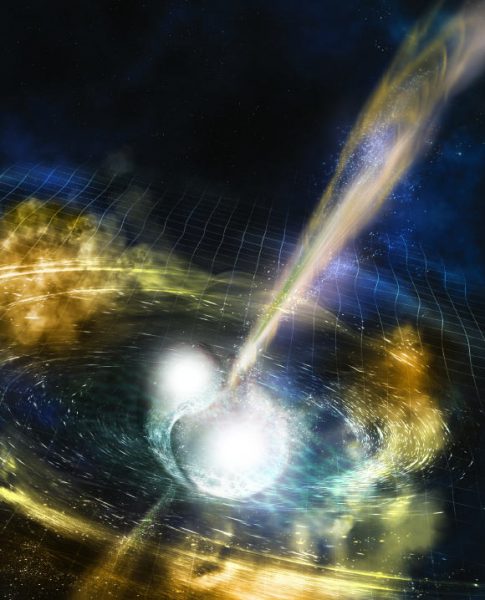Astronomers Develop New Method for Measuring Hubble Constant | Astronomy – Sci-News.com
The Hubble constant measures the current expansion rate of our Universe and plays a fundamental role in cosmology: it can be used to determine the Universe’s size and age, as well as serve as an essential tool for interpreting observations of cosmic objects. An international team of astronomers has used a combination of gravitational-wave and radio observations of GW170817, a merger of two neutron stars detected in 2017, to come up with a more precise value for the Hubble constant.

Artist’s illustration of two merging neutron stars. Image credit: NSF / LIGO / Sonoma State University / A. Simonnet.
Two leading methods of determining the Hubble constant use the characteristics of the Cosmic Microwave Background (CMB), the leftover radiation from the Big Bang, or Type Ia supernova explosions. However, these two methods give different results.
“The neutron star merger gives us a new way of measuring the Hubble constant, and hopefully of resolving the problem,” said Dr. Kunal Mooley, an astronomer at the National Radio Astronomy Observatory (NRAO) and Caltech.
The new technique is similar to that using the supernova explosions.
Type Ia supernovae are thought to all have an intrinsic brightness which can be calculated based on the speed at which they brighten and then fade away.
Measuring the brightness as seen from Earth then tells the distance to the supernova explosion.
Measuring the Doppler shift of the light from the supernova’s host galaxy indicates the speed at which the galaxy is receding from Earth. The speed divided by the distance yields the Hubble constant.
To get an accurate figure, many such measurements must be made at different distances.
When two massive neutron stars collide, they produce an explosion and a burst of gravitational waves.
The shape of the gravitational-wave signal tells scientists how ‘bright’ that burst of gravitational waves was.
Measuring the ‘brightness,’ or intensity of the gravitational waves as received at Earth can yield the distance.
“This is a completely independent means of measurement that we hope can clarify what the true value of the Hubble constant is,” Dr. Mooley said.
However, there’s a twist. The intensity of the gravitational waves varies with their orientation with respect to the orbital plane of the two neutron stars. The gravitational waves are stronger in the direction perpendicular to the orbital plane, and weaker if the orbital plane is edge-on as seen from Earth.
“In order to use the gravitational waves to measure the distance, we needed to know that orientation,” said Dr. Adam Deller, an astronomer at Swinburne University of Technology.
Over a period of months, the astronomers used radio telescopes to measure the movement of a superfast jet of material ejected by the GW170817 event.
“We used these measurements along with detailed hydrodynamical simulations to determine the orientation angle, thus allowing use of the gravitational waves to determine the distance,” said Dr. Ehud Nakar, from Tel Aviv University.
The astronomers calculated that the Hubble constant value was between 40.6 miles (65.3 km) and 47 miles (75.6 km) per second per megaparsec.
“This single measurement, of an event some 130 million light-years from Earth, is not yet sufficient to resolve the uncertainty, but the technique now can be applied to future neutron-star mergers detected with gravitational waves,” they said.
The team’s work appears in the journal Nature Astronomy.
_____
K. Hotokezaka et al. A Hubble constant measurement from superluminal motion of the jet in GW170817. Nature Astronomy, published online July 8, 2019; doi: 10.1038/s41550-019-0820-1





